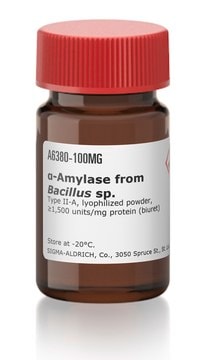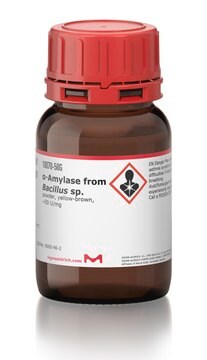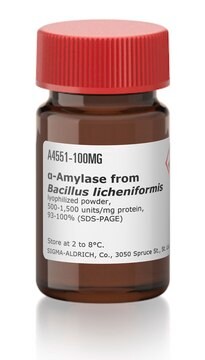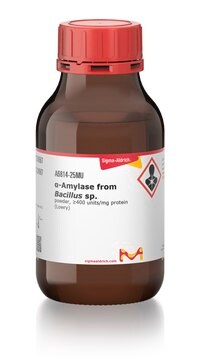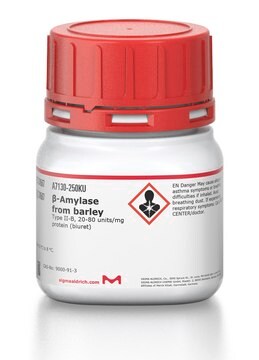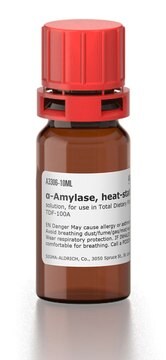Kluczowe dokumenty
10065
α-Amylase from Aspergillus oryzae
powder, ~30 U/mg
Synonim(y):
1,4-α-D-Glucan-glucanohydrolase
About This Item
Polecane produkty
Postać
powder
Poziom jakości
aktywność właściwa
~30 U/mg
masa cząsteczkowa
Mr ~51000
temp. przechowywania
2-8°C
Szukasz podobnych produktów? Odwiedź Przewodnik dotyczący porównywania produktów
Opis ogólny
Zastosowanie
- as a control enzyme in agar plate-based and carboxymethylcellulose-based clearing assays to screen cellulase activity
- for the hydrolysis of starch to explore the the role of wheat starch in frozen dough
- to inhibit Staphylococcus aureus biofilms
Działania biochem./fizjol.
Definicja jednostki
Inne uwagi
Hasło ostrzegawcze
Danger
Zwroty wskazujące rodzaj zagrożenia
Zwroty wskazujące środki ostrożności
Klasyfikacja zagrożeń
Acute Tox. 4 Oral - Resp. Sens. 1
Kod klasy składowania
11 - Combustible Solids
Klasa zagrożenia wodnego (WGK)
WGK 3
Temperatura zapłonu (°F)
Not applicable
Temperatura zapłonu (°C)
Not applicable
Środki ochrony indywidualnej
dust mask type N95 (US), Eyeshields, Faceshields, Gloves
Certyfikaty analizy (CoA)
Poszukaj Certyfikaty analizy (CoA), wpisując numer partii/serii produktów. Numery serii i partii można znaleźć na etykiecie produktu po słowach „seria” lub „partia”.
Masz już ten produkt?
Dokumenty związane z niedawno zakupionymi produktami zostały zamieszczone w Bibliotece dokumentów.
Klienci oglądali również te produkty
Nasz zespół naukowców ma doświadczenie we wszystkich obszarach badań, w tym w naukach przyrodniczych, materiałoznawstwie, syntezie chemicznej, chromatografii, analityce i wielu innych dziedzinach.
Skontaktuj się z zespołem ds. pomocy technicznej
